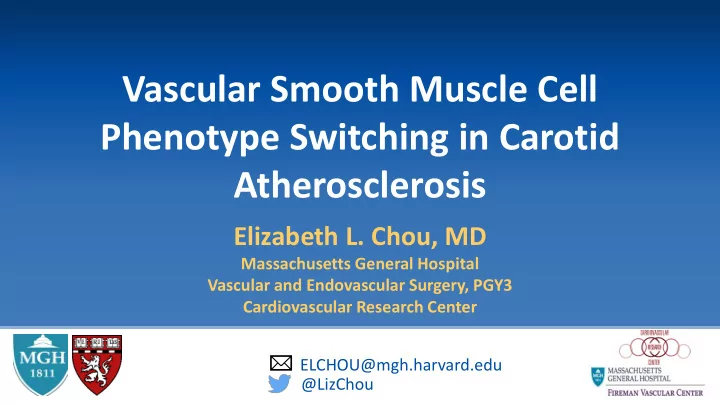

Vascular Smooth Muscle Cell Phenotype Switching in Carotid Atherosclerosis Elizabeth L. Chou, MD Massachusetts General Hospital Vascular and Endovascular Surgery, PGY3 Cardiovascular Research Center ELCHOU@mgh.harvard.edu @LizChou
INTRODUCTION • >100,000 CEAs annually • ~ ↓ 50% asymptomatic Rosenfeld. Nature Medicine. 2015 ➢ ~ ↑ 50% with stroke/TIA NIH: NINDS; Mayo Clinic Wallaert. Stroke . 2012
BACKGROUND : Carotid atherosclerosis Rosenfeld. Nature Medicine. 2015
BACKGROUND: VSMCs Rzucidlo et al. J Vasc Surg. 2007 Rosenfeld. Nature Medicine. 2015
BACKGROUND : HDAC9 • “Healthy” VSMCs, express contractile genes • ACTA2, SM22, MYH11 • Disease triggers binding of complex and silences expression of contractile genes ➢ Explore role of VSMC phenotype switching in carotid atherosclerosis ISGC et al. Nature Genetics . 2012 Lino Cardenas et al. Nature Communications. 2018
DESIGN: Cell model Surgical Specimen Animal models Primary human Molecular expression Mice Hdac9 -/- :Tagln-cre VSMCs treated with LDLR -/- on high fat diet patterns and genetic data cholesterol and (control, asymptomatic, symptomatic) phospholipids
RESULTS: Cell Model 10 Normalized mRNA expression CTRL *** Cholesterol *** 8 OxPAPC siHDAC9 Cholesterol 6 siHDAC9 OxPAPC *** *** p<0.0001 * p<0.05 *** 4 *** * *** 2 * * * *** *** 0 HDAC9 CD68 LGALS3 ACTA2
RESULTS: Cell Model # of migrated monocytes per frame Control ** 25 Control siHDAC9 CH 20 CH siHDAC9 ** p <0.05 ** 15 10 5 0 4 hr 12 hr Incubation time
RESULTS: Cell Model What is PN-1? PN-1 relative expression 8 Normalized mRNA expression *** *** *** p<0.005 6 4 *** 2 0 Control CH CH siC CH siHDAC9 Bouton. Blood. 2012
RESULTS: Surgical Specimen Control Asymptomatic Symptomatic Control Asymptomatic Symptomatic n=13 n=35 n=24
RESULTS: Surgical Specimen Control Asymptomatic Symptomatic n=13 n=35 n=24 DAPI/PN-1
RESULTS: Surgical Specimen
NEXT: On the horizon • What’s causing the change? How to stabilize the contractile phenotype to mitigate or prevent disease progression • What is PN-1 • HDAC9 associated proteins and pathways • Further delineate VSMC – macrophage relationship • Unbiased discovery complex tissues – plaque, vasculature • Exploring the potential of patient tissues • Similar models to expand our understanding of other vascular pathologies
NEXT : Banking for the future/now • MGH Vascular Tissue Bank • Control tissues – carotid, segmental aortic arch, descending thoracic aortic, abdominal aortic tissue, lower extremity vasculature • Disease specific tissues – Marfan, vEDS, LDS, sporadic TAA, AAA, Type A and B dissection, carotid tissue, pulmonary veins with AF • Total of over 200 unique patients
NEXT : Why use single nuclei sequencing • Vascular tissues are composed of many different cell types which change in phenotype throughout health and disease • Agnostic approach to evaluate vascular tissue and discover its diversity • Comprehensively assess the expression status of different cell types and changes in gene expression in health and disease • Identify rare cell populations that are specific to disease • Identify targets for treatment • Why hasn’t this been done already?
TISSUE USE(S) : Single nuclei analysis Tissue isolation Section, digest, homogenize, filter Filtered nuclei in suspension Nuclei captured with Barcoded cDNA sequenced Nuclei are lysed and undergo barcoded beads + reagents for analysis reverse transcription
CONCLUSION • Preserving the VSMCs contractile phenotype may have a role in atherosclerosis and vascular tissue degeneration • Vascular tissue is valuable • Patient’s role in research and discovery • Surgical outcome improvement, quality of life, morbidity and mortality • Biology is inherently associated with outcomes
ACKNOWLEDGEMENTS MGH Vascular Surgery MGH CVRC Lindsay Lab Christian Lino Cardenas Malhotra Lab Stone / Juric RA Program Broad Bayer Precision Cardiology Lab Patrick Ellinor Thank you! Questions/Comments/Suggestions MGH CVRC T32HL007208 ELCHOU@mgh.harvard.edu VESS Research Grant @LizChou
Recommend
More recommend